
129
Strategies
for
Teaching
the
Articles
a, an,
the
Amelia
Leong
Chiew
Har
(Universiti
Putra Malaysia, Malaysia)
Abstract
It is undeniable that learning the articles a, an, and the presents serious difficulties to the
learners and teachers alike in the English Language classrooms, but previous studies done on
the teaching of articles have shown that there are many techniques of teaching the articles that
can be employed in the English Language classrooms. Besides the techniques suggested by
the linguists and researchers, the paper also presents strategies on teaching the articles from
various sources like grammar books and research journals in the area. Examples of the
teaching strategies are given in relation to the strategies suggested.
Introduction
The English grammar articles a, an and the is categorized as the determiners in the English
grammar. The English articles system is one of the most commonly used aspects of grammar
in the English Language. According to Thornbury (2004, p.8), the articles a and the are the
two out of the ten most frequent words in the English Language. The articles system is used
widely and frequently; intentionally or unintentionally in all the four skills speaking,
listening, writing and reading. It plays a crucial role in learning the language as it helps to
achieve accuracy and fluency in English language and to achieve communication skills.
for the non-
1990, p.461). Hence, it is important to teach the usage of the articles to the learners.
In Malaysia, the Ministry of Education (MOE) has listed all the three articles a, an, the in
the Form 1 to Form 5 English Language Kurikulum Bersepadu Sekolah Menengah (KBSM)
syllabus. This shows that all the three articles will be taught to the learners from Form 1 to
doi:10.7575/aiac.alls.v.2n.2p.129
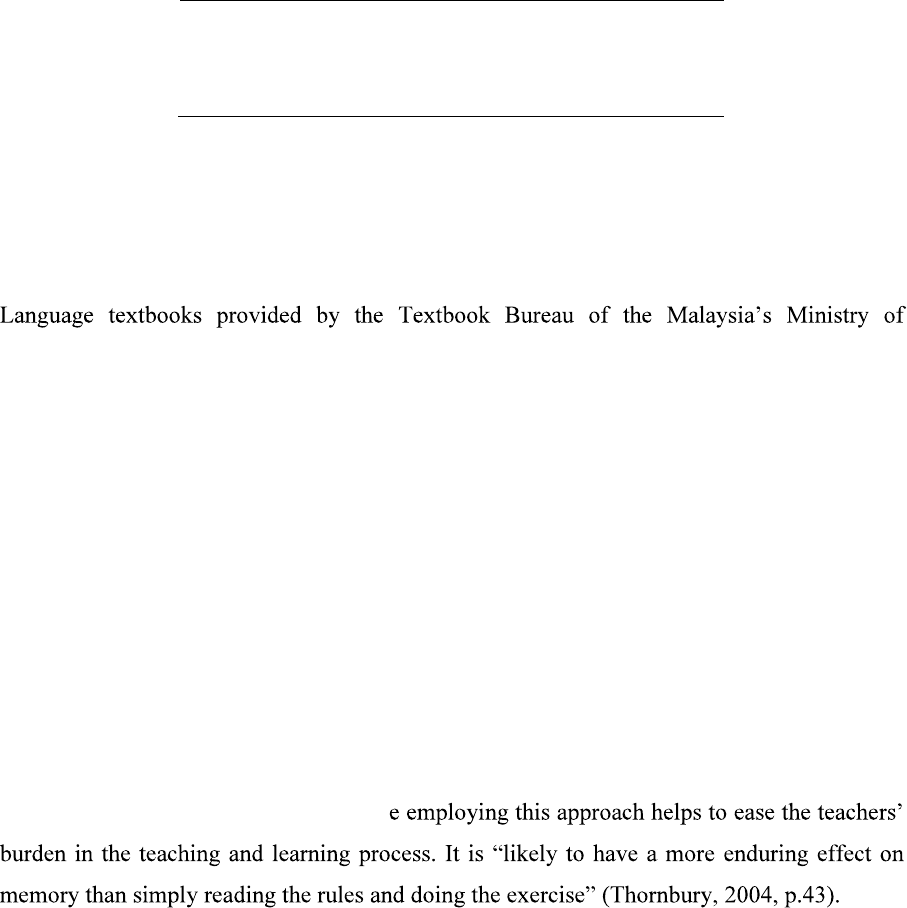
130
Form 5 English Language classrooms. Table 1 shows the list of articles listed in the
Malaysian Secondary School English Language syllabus.
Table 1: Curriculum specification for English language (articles) in Forms 1-5
Form 1 A, An, The, Zero Article
Form 2 A, An, The, Zero Article
Form 3 A, An, The, Zero Article
Form 4 A, An, The, Zero Article
Form 5 A, An, The, Zero Article
Source: Curriculum Specification for English Language (MOE, 2003)
Hence, the articles are expected to be taught to the learners in the English Language
classrooms. In Malaysia, the articles are taught to the learners mainly by using the English
Education.
Thornbury (2004, p.41) in How To Teach Grammar shows us how the articles can be
possibly taught in the English language classrooms using the deductive approach by
involving the learners in the jigsaw activities and group work, utilizing the cloze texts. It is
believed that jigsaw activity and group work help to provide more opportunities to the
learners to be involved in the real-world communication and training the learners to be more
responsible to their own learning. Thornbury (2004, p.43) also reported that this approach of
teaching articles is economical as teaching articles can be easily done by directing the
learners to the rules of grammar in the handouts prepared by the teachers or referring the
learners to the grammar sections of a reference book. Teaching the grammar articles solely by
the teachers is not an easy attempt, henc
Teaching grammar
Previous studies on the teaching of grammar have shown that there have been debates on the
process of teaching and learning the English grammar. Some argue that grammar should not
be taught but it must be acquired by the learners through their daily communication and use
of the English Language (Webbe, 1622 in Thornburry, 2004, p.19). This approach is called
131
Inductive Approach and is supported by the Communicative Language Teaching (Richards
and Rogers, 1986). The proponents of this approach contend that grammar can be acquired
(picked up) by the learners naturally without studying the rules of grammar. Hence, the
inductive approach supports the Direct Method and Audiolingualism as the grammar teaching
and learning methodology in the English Language classrooms. The Direct Method claimed
to be supporting the Natural Approach by Krashen (1974) while the Audiolingualism strictly
rejected the idea of grammar teaching, based on the idea of behaviorism (Skinner, 1974).
On the other hand, others have argued that in order to learn grammar effectively, one has to
first study the rules of the grammar (deductive approach). There is a need for the learning of
the rules to take place first as the learning of rules enables the production of new sentences in
the language. Reportedly the teaching and learning of the grammar rules can prevent
fossilization of errors to take place in Second Language Learning (Selinker, 1972) as learners
are aware of the grammar rules and prevent them from using the grammar inaccurately. This
deductive approach in the learning of grammar leads to the emergence of a grammar teaching
method that can be applied and employed in the teaching of the grammar in the English
Language classrooms. The teaching method that puts forward the teaching of the rules of
grammar is the Grammar-Translation Method which teaches the rules of grammar in the
beginning of the lessons and grammar is taught explicitly rather than implicitly in the English
Language classrooms.
Therefore, both approaches have advantages and disadvantages. Whether one should teach
grammar inductively or deductively highly depends on the learning-teaching context. It
depends highly on the teachers, the learners and the grammar teaching methods used by the
teachers to make the teaching and learning of grammar effective (Thornbury, 2004).
The teaching of articles
Previous studies done on the English grammar articles have highlighted several teaching
techniques and approaches that can be employed in the teaching of the articles a, an and the.
As the learning and acquisition of the English grammar articles has always posed problems to
the learners; hence, linguists have came out with several teaching techniques and approaches
in teaching the articles so that the teaching and learning process of the articles will be more
effective.
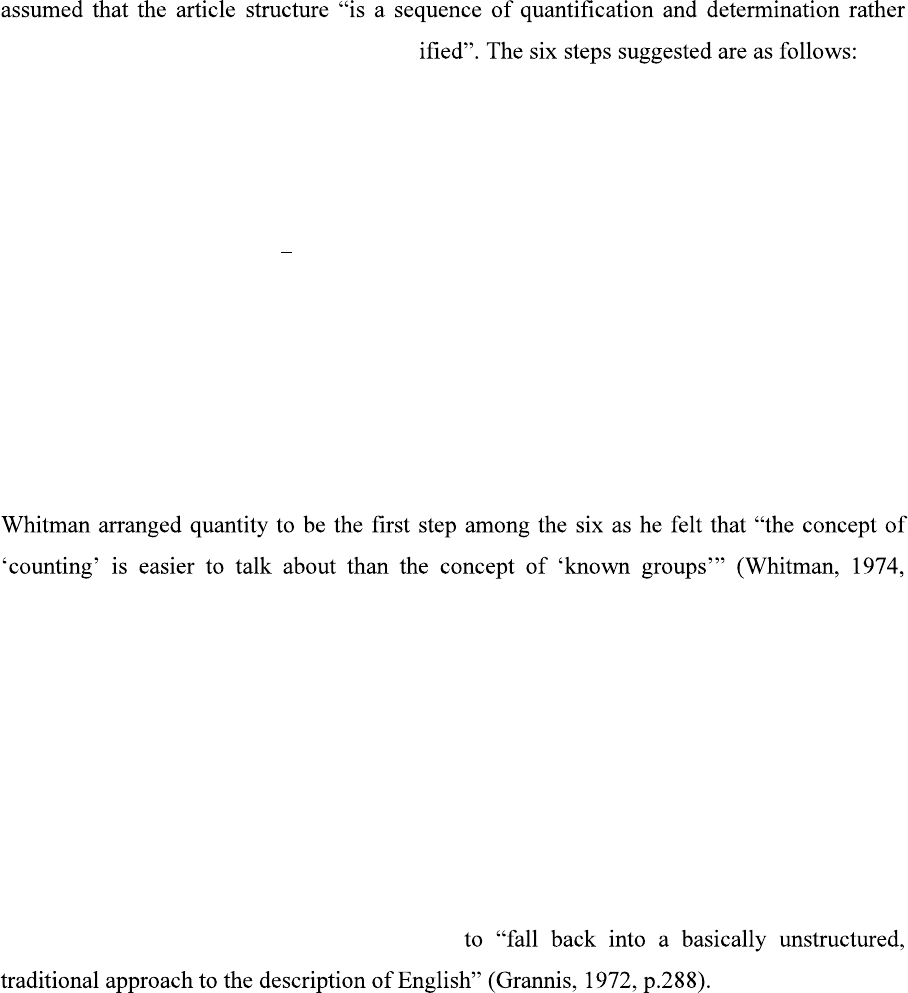
132
Whitman (1974, p.253) has suggested six consecutive steps for teaching the articles as he
than a choice between specified and unspec
1. Quantity (singular/plural distinction)
- eg. John has a book vs. John has four books.
2. Generic plural
- eg. All apples are red vs. Apples are red.
3. Non-count nouns (Non-count vs. count and a lot of vs. much and many)
- eg. John drank a lot of water vs. John bought a lot of books.
- eg. Do we have much water? vs. Do we have many books?
4. Determiners (which NP questions and first /subsequent mention)
- eg. Which books are red? The red books are on the table.
- eg. I read a book. The book was called Dracula.
5. Quantity and determiner
- eg. One of the books on the table is blue.
6. Generic articles
- eg. Elephants never forget.
- eg. An elephant never forgets.
- eg. The elephant never forgets.
(Examples are taken from Whitman, 1974, p.253)
p.258). He placed the generic article a and the the last among the six as the generic a and the
are the least found.
On the other hand, Grannis (1972) has posited that the best way for the learners to learn the
English grammar articles and for the teachers to teach the articles is to employ the traditional
approach. Grannis (1972) opposed to the ideas of teaching the articles based on the theory or
concept in explaining the use of the articles as the formal instructions. He (ibid.) also reports
that the theory in the grammar books might lack the real ideas and information on the usage
of the articles. Thus, he urged the teachers
On the contrary, Lindstromberg (1986), Berry (1991) and Master (1997) have argued that
formal instruction of articles is needed and contributes to the effectiveness in the learning
process. They (ibid.) believe that the formal instruction is needed to aid the non-native
learners to acquire the positive results in the learning of the articles. Lindstromberg (1986)
posits that the formal instruction of articles helps to explain and simplify the complex system
of the English grammar articles.
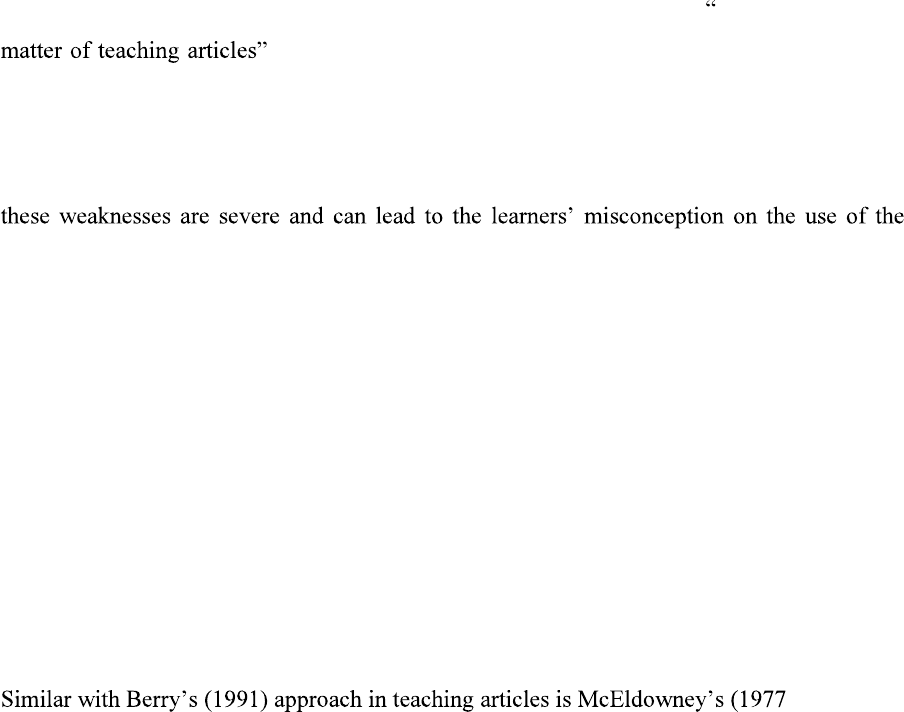
133
Although Berry (1991) supported the use of formal instruction and the learning of grammar
rules in the teaching and learning of the English grammar articles, he found out that what
were written in the grammar books with regards to the articles were not yet well in the
(p. 255). Berry (1991) reported that there are weaknesses in the
grammar books on the explanations on the articles as there are incorrect or misleading
information on the articles a, an, the, unwarranted emphasis on certain types of article usage
and a lack of variety in the techniques of teaching the articles. According to Berry (1991),
articles. Based on these three weaknesses, Berry (1991, p.256) has come up with seven
principles in designing activities for the teaching and learning of articles,
1. Use a principled descriptive account as a basis;
2. Concentrate on the, particularly its specific uses;
3. Emphasize, wherever possible, the value of articles, using contrastive information if appropriate;
4. Make exercises/activities varied and interesting; involve and challenge the learner; use different
formats and different stimuli, for example sound, pictures; include open-ended exercises which
allow learners to discover the bounds of usage;
5. Do not rely on rules; use them as a back-up to other activities and make sure the formulations are
simple but accurate;
6. Grade the focus on particular aspects, but do not try to control the introduction of uses; articles
are far too numerous for this;
7. Have exercises which, in addition to production, involve comprehension and perception (e.g. a
text with gaps for articles which learners fill in according to a passage they hear)
) four stages
of teaching approach,
Stage 1: Classification
a + N (any one) vs. the + N (the special one)
Choose a bag vs. Take a red bag.
N + s (plural classification)
These are bags.
Stage 2 : Plurality
some + N + s (any ones)
Choose some bags from the collection.
the + N + s (the special ones)
Take the red bags.
Stage 3 : Mass or substance
N (the substance in general)
Mud is found at the bottom of rivers.
Some + N (any substance)
Some mud is grey; some mud is black.
the + N (the special substance)
Point to the black mud.
Stage 4 : Numbered specific; generic
numeral N + s (any numbered ones)
Choose six pens from the collection.
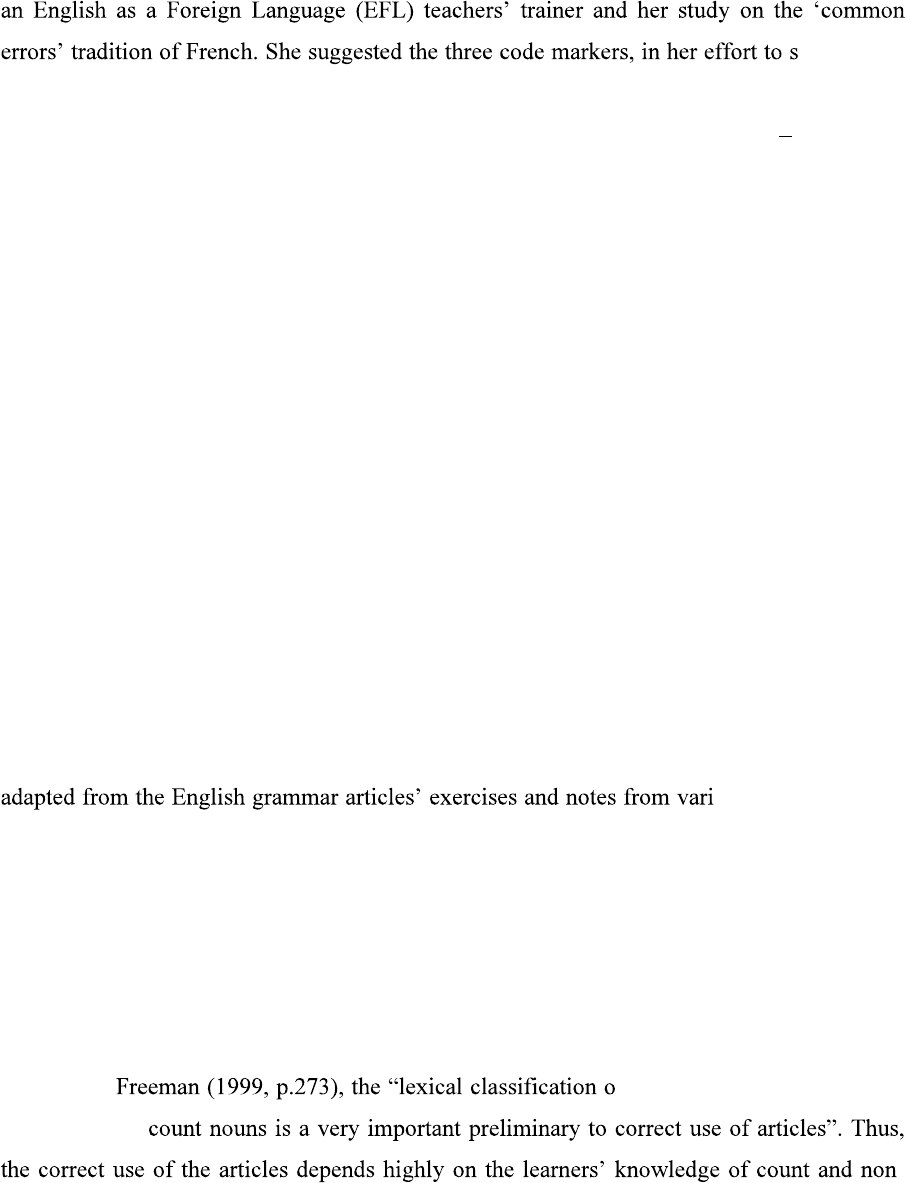
134
a + N/ the + N (ones in general)/ the + N + s
An elephant never forgets.
The elephant never forgets.
The elephants never forget.
(Taken from McEldowney, 1977, p.110)
McEldowney (1977) suggested the four-stage teaching approach based on her experience as
implify the
English grammar articles which are (1) choice marked by a in the sense of any; (2)
specification coded through special the; and (3) generalization through general s and a and
the. The four-stage teaching approach is basically formed based on these three code markers
by McEldowney (1991) herself.
From all the previous studies that have been mentioned, all of the suggestions by the
practitioners are on developing a simplified framework for the teaching of the articles to the
learners. There are a lot of emphases on the ways the teaching of articles can be made simple
as to provide clearer explanations and input on their and to better help the learners to achieve
mastery in the learning of the article usage.
Teaching strategies on articles
As English grammar articles pose great difficulties for both the teachers and learners of
English as a Second/Foreign Language (ESL/EFL), this paper suggests a few teaching
strategies for teaching them, aiming to help both teachers and learners to teach and learn the
English grammar articles effectively and to achieve a successful teaching and learning
process of the articles in the classrooms. The following teaching strategies suggested are
ous grammar books
and journals on the teaching of English grammar articles.
First and foremost, teachers are encouraged to tap on the concept of noun countability before
start to teach the English grammar articles to the ESL/EFL learners. It is crucial to educate the
learners on the distinction between count nouns and non-count nouns in order to help the
learners to distinguish between count nouns and non-count nouns. According to Celce-Murcia
and Larsen- f English common nouns into
count and non-
-
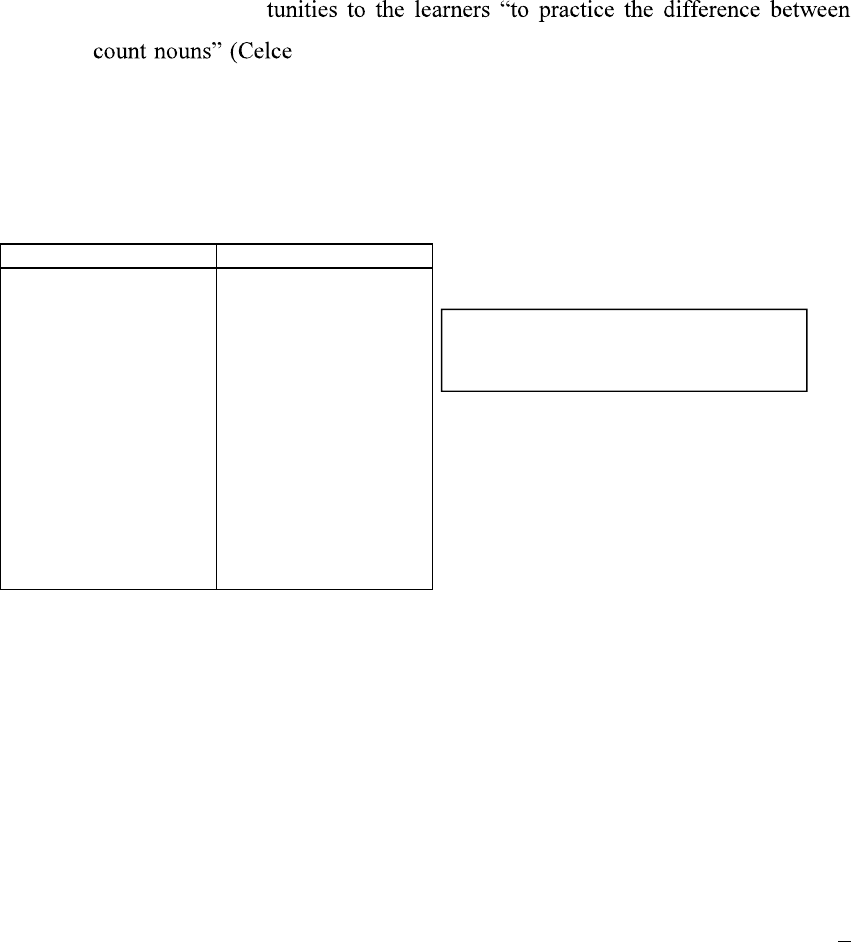
135
count nouns. Celce-Murcia and Larsen-Freeman (1999, p.290) have also suggested on
teaching the count and non-count nouns prior to the teaching of the articles to the learners.
Hence, teachers should provide exercises and activities on count and non-count nouns to the
learners as to provide the oppor
count and non- -Murcia and Larsen-Freeman, 1999, p.290). This can be
done by creating exercise/activity with table or grid with two columns separating the count
noun from the non-count nouns and ask the learners to sort the given nouns into the
appropriate columns whether the noun should be in the count noun column of the non-count
noun column. For example,
Count Nouns Non-Count Nouns
(adapted from Badalamenti and Henner-Stanchina, 1997
in Celce-Murcia and Larsen-Freeman, 1999, p.290)
It is believed that this type of activity aids the learners to gain a clearer idea on the distinction
of count noun and non-count noun that will helps the learners in using the accurate article
with the noun.
Next, when the learners are equipped with the appropriate and sufficient knowledge on count
and non-count nouns, then, it would be the right time for the teachers to introduce the articles
to the learners. Teachers can introduce the articles based on the definiteness of the articles
the definite article and the indefinite articles. In line with what suggested by other linguists
such as Whitman (1974) and Berry (1991), the teaching of articles have to be done 1 step at
one time, therefore, it would be best that teachers start teaching on the indefinite articles
(a,an) first and followed by the indefinite article (the). Exercises that can be given to the
learners to work on the indefinite and definite articles would be fill in the blanks where
learners are ask to fill in the blanks in the sentences given with the appropriate article. For
instance,
money, an egg, dresses, furniture, a table,
coins, clothing, food, a chair, a pencil,
information
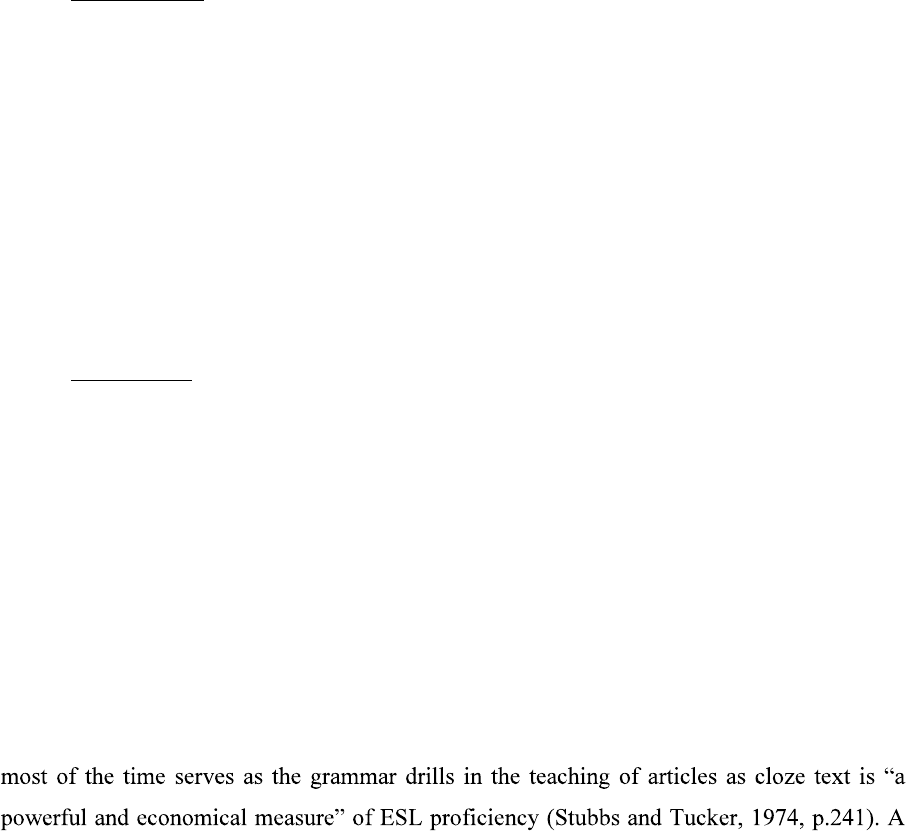
136
Indefinite article
This is _____ pen. (a/an)
This is _____ eraser. (a/an)
This is _____ bird. (a/an)
This is _____ eagle. (a/an)
(adapted from Celce-Murcia & Larsen-Freeman, 1999, p.290)
This exercise is aimed to provide the opportunity to the learners to be able to identify and use
the appropriate indefinite article with the noun given.
As for definite article, the exercise would be similar to the exercise for the indefinite article
but more information would be given to aid the learners to identify the use of the definite
article.
Definite article
That is my pencil. Can you please pass ______ pencil to me?
_____ water in this cup is filthy.
Please submit _____ form to me.
(adapted from Celce-Murcia & Larsen-Freeman, 1999, p.290)
The above exercise on the definite article above highlighted on the use of definite article the
with the nouns that are mention for the second time and with the non-count noun.
Once the learners have the knowledge on the use of the definite and indefinite articles,
teachers can slowly introduce the exercises that are of higher cognitive level, for instance, the
cloze text. The cloze text is the most used exercise / activity in the teaching of articles and
cloze text which is well constructed is capable to test language skills, and even the mastery of
grammatical items ranging from the most basic to the most advanced (Gan, 2001, p.2) Hence,
cloze text is also used for testing purposes. An example of an easier cloze test is as follows:
Instruction: Listen as your teacher reads the following passage, fill in the articles you hear the
teacher say.
Before going out of town, I asked _________ friend to keep my car in his garage for __________
couple of days. He agreed. When __________ emergency arose, he used my car and ____________
accident occurred in which ____________ car suffered damages. Is ____________ friend
responsible for ____________ damages? Yes. Without clear permission to use _____________ car,
he has no right to use it for his personal benefit.
(taken from Rinnert and Hansen, 1986, p.17)
The cloze text above is the most basic and the easiest cloze test as learners do not have to
decide for themselves on which articles that they should use but fill in the blanks in the cloze
test with the articles that their teachers dictate in the lesson.
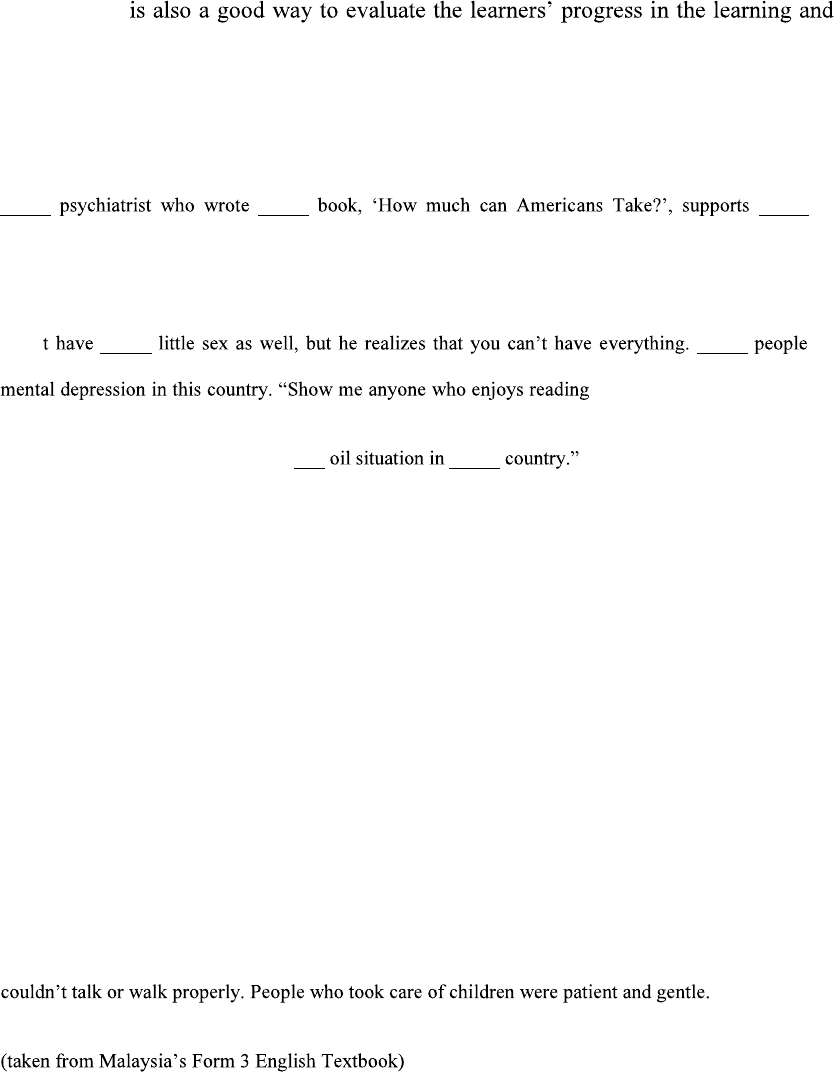
137
Apart from this cloze test, there are also some other cloze texts which are more difficult and
advanced that cater for the advanced learners. Using the most basic cloze text to the more
advanced cloze text
mastery of the use of the articles.
Instruction : Fill in the blanks with a, an or the.
During _____ Watergate scandal of _____ early seventies, everyone from Joseph Alsop to President
Gerald Ford was pleading that _____ country should forget about Watergate so _____ President
could devote his time and efforts to such important matters as _____ energy crisis. Dr Siegfreed,
opposite view. He says it would have been more advantageous if _____ country could forget about
_____ energy crisis so _____ President could devote his full time to Watergate. _____ truth is, he
claims, that everyone in _____ country got _____ fiendish delight in reading about Watergate, while
very few people got any fun out of reading about _____ oil crisis. Watergate was _____ pure
entertainment. It had _____comedy, _____mystery and _____melodrama. He would have preferred
that i
identified with _____ Watergate characters. Without Watergate you would have had _____ mass
about _____ energy crisis.
Produce one soul who gets _____ pleasure put of seeing long lines of _____ cars at _____ gas
stations. Find me _____ person who gets any pleasure out of watching Administration officials give
_____ daily conflicting stories on __
(taken from Rinnert and Hansen, 1986, p.23)
The cloze text given above is one of the cloze texts used in the teaching of articles in the ESL
classrooms. This type of cloze text caters best for the advanced learners or for the learners
who have excellent mastery on the article usage.
If learners are capable and face no difficulties in completing the above cloze text, then,
teachers can proceed to a higher level of the teaching of articles which will involve a
grammar-checking activity where learners are required to act as the teacher to line out the
missing articles that are supposed to be in the passage given. All the articles are omitted on
purpose for this activity.
Instruction : Rewrite the passage below using a, an and the where appropriate.
Today, our class visited home for disabled children. Some of children were in wheelchairs. Some
We had party with people there. We also put up show for them. It was enjoyable day for both
children and us.
The example given is a short passage which is suitable to be attempted by the Malaysians
Form 3 learners. Teachers can develop or adapt the passages with the appropriate length and
level of difficulty which are suitable to cater the learners of different ages and level of
proficiency.

138
Finally, teaching ge of articles in
their writings. es
used in them. Each articles used in the writing will be judged by the teachers on their
appropriateness and accuracy. Every inaccurate articles used will be kept in records and
emphasized to the learners in order to prevent the learners from committing the same errors in
using the articles. According to Master (1995 in Celce-Murcia and Larsen-Freeman, 1999,
articles, be aware of
the article errors that they often commit and improve the article usage of the learners.
Conclusion
The teaching and learning of the article usage has never been easy to both the teachers and
learners of the English Language. Hence, strategies for teaching the articles a, an, and the are
suggested to ease the teaching process of the articles in the classrooms, besides, helping the
learners to achieve excellent mastery in the use of articles. These strategies are also outlined
as a means to ensure that the teaching and learning process of the English grammar articles
will be effective.
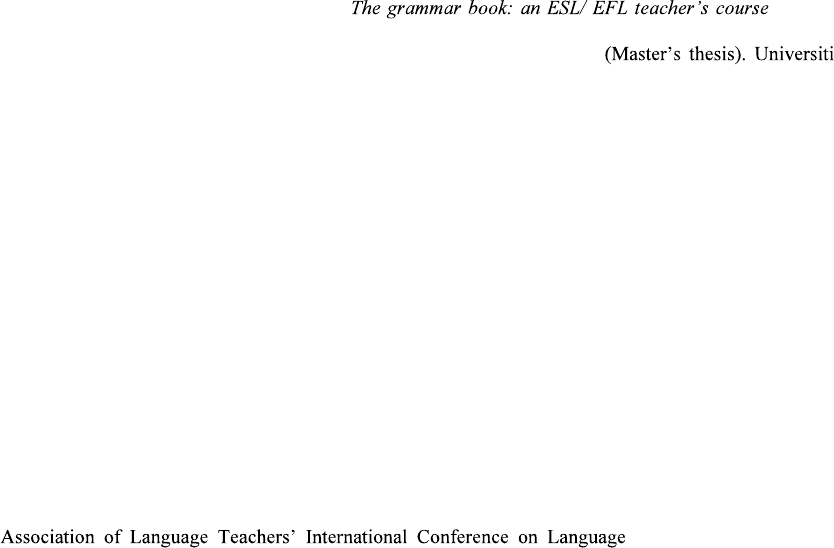
139
References
Ahmad Salihin bin Mat Saat, Mohd Salleh bin Salehin and Wan Zuraidi bin Wan Zaid, (2003). English Form 3.
Ee Ewe Hock (Editor). Sutrapadu (M) Sdn. Bhd.: Petaling Jaya.
Berry, R. (1991) Re-articulating the articles. English Language Teaching Journal, 45(3) 252-259. London:
British Council.
Celce-Murcia, M. and Larsen-Freeman, D. (1999). . 2
nd
ed.
Boston: Heinle and Heinle.
Gan, C.W. (2001). The cloze test as an integrative measure of ESL proficiency
Putra Malaysia, Selangor.
Grannis, O. (1972). The definite article conspiracy in English. Language Learning, 22(2), 275-289.
Lindstromberg, S. (1986). Guidelines for teaching the English article system. Cross Currents, 13 (1), 31-41.
Malaysia. Ministry of Education (2003). Curriculum Specifications for English Language Form 1. Kuala
Lumpur: Curriculum Development Centre.
Malaysia. Ministry of Education (2003). Curriculum Specifications for English Language Form 2. Kuala
Lumpur: Curriculum Development Centre.
Malaysia. Ministry of Education (2003). Curriculum Specifications for English Language Form 3. Kuala
Lumpur: Curriculum Development Centre.
Malaysia. Ministry of Education (2003). Curriculum Specifications for English Language Form 4. Kuala
Lumpur: Curriculum Development Centre.
Malaysia. Ministry of Education (2003). Curriculum Specifications for English Language Form 5. Kuala
Lumpur: Curriculum Development Centre.
Master, P. (1990). Teaching the English articles as a binary system. TESOL Quarterly, 24(3), 461-478.
Master, P. (1997). The English article system: Acquisition, function, and pedagogy. System, 25,215-232.
McEldowney, P.L. (1977). A teaching grammar of the English article system. International Review of Applied
Linguistics, 15(2), 95-112.
Richards, J. C. & Rogers, T. S. (1986). Approaches and methods in language teaching: A description and
analysis. Cambridge, UK: Cambridge University Press
Rinnert, C., & Hansen, M. (1986, October). Teaching the English article system. Paper presented at the Japan
Teaching and Learning.
Tokyo, Japan.
Selinker, L. (1972). Interlanguage. IRAL, 10(3), 209-31.
Skinner, B. F. (1974). About behaviorism. New York: Alfred A. Knopf.
Stubbs, J.B. & Tucker, G.R. (1974). The cloze test as a measure of English Proficiency. Modern Journal, 58,
239-241.
Thornbury, S. (2004). How to teach grammar. Malaysia: Pearson Education Limited.
Whitman, R.L. (1974). Teaching the article in English. TESOL Quaterly 8(3), 253-262.
Yamada, J. & Matsuura, N. (1982). The use of the English article among Japanese students. RELC Journal,
13(1), 50-63.
